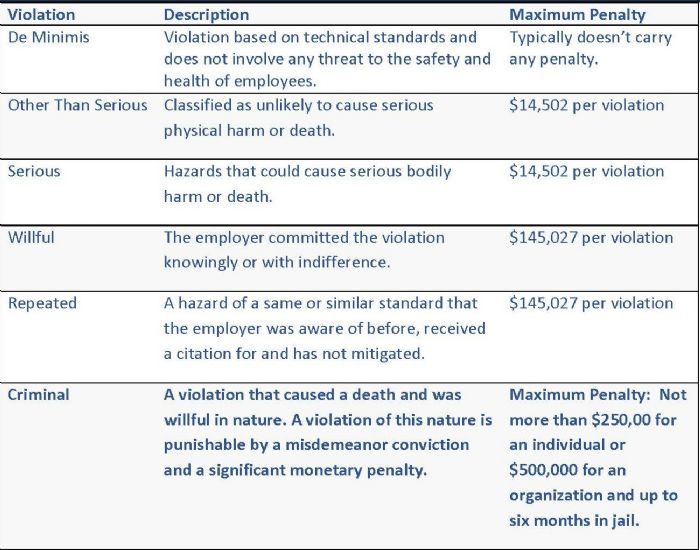During the Opening Conference
… determine the purpose of the inspection. If there has been a complaint, ask for a copy of the complaint. OSHA will protect the identity of any employee who has submitted a complaint. Then define the scope of the inspection and limit consent only to the areas cited in the complaint. Configure a route for the walk-around and keep the walk-around as limited as possible.
Identify areas of the workplace or documents that might
contain proprietary information and confirm with the CSHO that all proprietary
information will remain confidential. Discuss the process for conducting
employee interviews and producing documents. If possible, schedule employee
interviews to ensure shift coverage.
Ask the CSHO to submit all requests for company information and documents in writing and have your company’s legal counsel review these requests.
During the Walk-around
… ensure all employees have the required PPE and are following proper safety protocols. Keep the route as limited as possible, while understanding the plain view doctrine. That is, a CSHO can investigate any hazard observed while walking through the premise.
Take detailed notes to document the CSHO’s findings, and yours. Be sure to take your own pictures, samples and measurements, duplicating any taken by the CSHO. Your company can request that samples and monitoring occur at a time when the company can conduct its own sampling and monitoring.
If you or the CSHO identifies any “quick-fix” items, remedy them immediately. The CSHO will view these actions as proof of your company’s willingness to comply with safety and health laws.
Do not interfere with employee interviews. The CSHO has the
right to conduct employee interviews in private. Employee interviews may
involve labor representatives, rank-and-file employees and management
personnel. For any interview of a company decisionmaker, consider having a
representative present, as any statements made are considered binding
admissions on the employer.
During the Closing Conference
.. request copies of all OSHA samples and monitoring reports
from the CSHO. Ask him to provide acknowledgment of receipt for all
documentation provided during the inspection. Also, provide the CSHO with the
name, title and contact information of the people to whom all OSHA
correspondence should be directed.
Document any alleged violations that already have been corrected. If directed by legal counsel, provide additional information and documentation relevant and supportive of the company’s position, as well as any information showing abatement of any alleged violations.
Do not make any impulsive commitments, such as corrective actions or dates. Discuss possible violations. Understand that only the OSHA area director can issue citations, and this process can take up to six months following the inspection. The area director may rely on a CSHO’s recommendations to issue a citation, but CSHOs may be hesitant to address whether they will recommend a citation during their visit to your facility.
After the Closing Conference
Try to obtain all sample and monitoring reports from OSHA and provide to your company’s legal counsel copies of all documents provided to OSHA, including all the notes, photographs, videos, etc. taken during the inspection. Reference an updated copy of OSHA’s Field Operations Manual and review it to determine whether there were any issues during the audit. You can use any information found as supporting documentation to negotiate a settlement.
 If your facility receives citations from OSHA, you should:
If your facility receives citations from OSHA, you should:
- Post the citation in all areas in which the violation
occurred. Citations must be posted for three working days or until the
violation has been corrected, whichever is later.
- Immediately notify your legal counsel about the citation and
send them a copy of the citation.
- Start the abatement process. Review all areas noted by the
CSHO and all violations from previous inspections and correct any issues found
within the timeframe stated on the citation. Document the corrections to show
that you completed the abatement process.
- Be sure to correct all hazards, or you may be assigned larger
penalties during subsequent inspections.
- Make note of all deadlines to avoid creating a short
turnaround time for completing abatement measures.
Appeals Process
Once you receive a citation, you can schedule an informal
conference with the OSHA area director to discuss the violations and try to
reach a settlement agreement. If unable to reach an agreement, you can either
pay the citation or file a Notice of Contest to pursue a formal hearing.
During the informal conference with the OSHA area director,
you can discuss citations, penalties, abatement dates or any other information
pertinent to the inspection. Though they are informal, properly prepare for the
conference. Employers can present defenses to citations, and OSHA may agree to
withdraw some citations or reduce the penalty.
Tips for productive informal conferences:
- Schedule the conference promptly; it must be held before the
end of the 15-day period for filing the Notice to Contest. Note: There may be
some differences in timelines and procedures between federal OSHA offices and
agencies run by OSHA-approved state programs.
- Discuss citations and remedial measures taken. If you want
OSHA to vacate the citation, be ready to explain why the citation is incorrect
or unwarranted.
- Use supporting documents. Prepare and review your case with your company’s legal counsel and use an evidence-based approach. Be sure that OSHA has objective evidence regarding each alleged violation and explain any mitigating circumstances and showcase your company’s commitment to safety.
- Keep track of all issues and their status; you want to make sure
that every item was resolved.
Remember, OSHA area directors want to reach a settlement.
Their main goal is to ensure that you rectify the identified hazards and attain
compliance. If you do not reach a settlement conference, then decide whether
you should pay the fine or contest it. There may be a reduction in the penalty
if the inspection went well; you may have to pay the penalty early to pay the
discounted amount.
If you decide to contest the citation, be sure to review timelines and dates for submitting requests and documentation. When filing a Notice of Contest, the file transfers over to the Department of Labor, to the Office of the Solicitor to begin litigation. A formal hearing will be scheduled and occur in front of an Administrative Law Judge. Formal hearings can be appealed in federal court. MF
See also: Pitcher Insurance Agency, Inc.
Technologies: Safety







 If your facility receives citations from OSHA, you should:
If your facility receives citations from OSHA, you should: 
